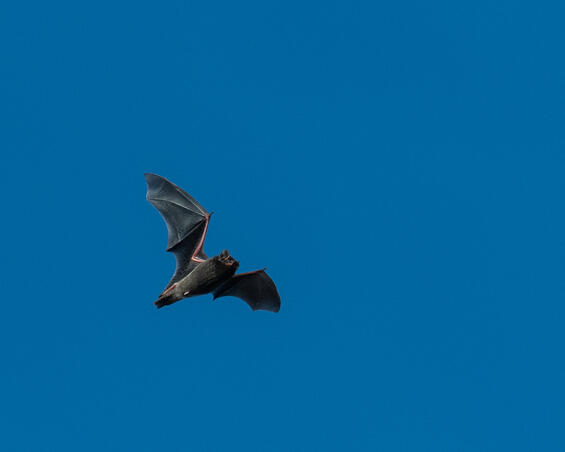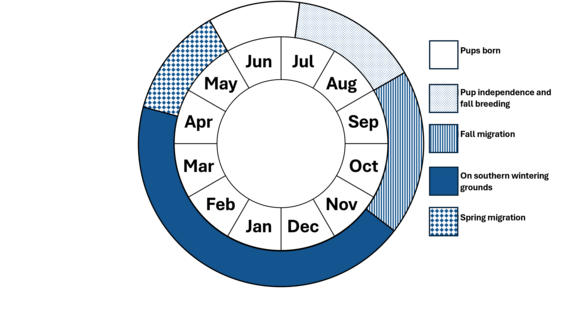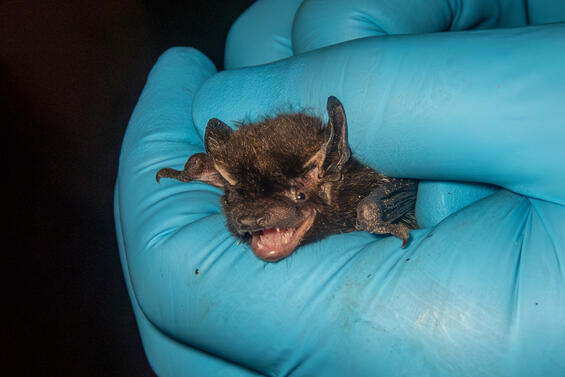- Scientific name: Lasionycteris noctivagans
- Species of Greatest Conservation Need (MA State Wildlife Action Plan)
- Special Concern (MA Endangered Species Act)
Description

Silver-haired bat (Lasionycteris noctivagans)
The silver-haired bat is dark blackish brown with silver-tipped guard hair on its back. It measures 80-116 mm (3.1-4.6 in) in total length and 7 to 16.7 g (0.2-0.6 oz) in weight. The forearm length is 37-44 mm (1.4-1.7 in). All three species of tree bats have well-furred tail membranes and short, rounded, well-furred ears.
Similar species: The other two species of tree bats in Massachusetts are the eastern red bat and the hoary bat. Both species have a different color pattern than the silver-haired bat.
Life cycle and behavior

Silver-haired bats are usually solitary, occurring together only to mate and care for their young. They may also be loosely drawn together while feeding and during migration. Like neotropical migrant songbirds, the tree bats migrate south for the winter, returning north in the spring. The peak of fall migration is from mid-August to October. The spring migration north is from April to June. Silver-haired bats are typically the first bat to appear in the evening, sometimes appearing in daylight. Eastern red bats also emerge very early in the evening.
Pregnant females may roost alone, or they may join other females to form maternity colonies of up to 55 bats. Two (rarely one) pups are born in late June or early July and are weaned in about 36 days. Although silver-haired bats are present in Massachusetts all summer, reproduction has not yet been documented. Longevity can be up to at least 12 years.
Population status
The silver-haired bat was listed in Massachusetts as a species of special concern in 2024, based on concerns for the species globally and regionally. Evidence suggests that all three species of tree bats have been declining in the Northeast. Silver-haired bats are the most uncommon of the three species of tree bat in the state, with records from only 33 of the 351 municipalities in 11 of the 14 counties.
Distribution and abundance
Silver-haired bats are found in all 48 contiguous states, except Florida and parts of the Gulf Coast and Southwest. In Canada, they are found from southern Nova Scotia, west across most of the southern forested regions to British Columbia. In Massachusetts, the silver-haired bat occurs statewide, but as for all three of the tree bat species, is most often seen on the coast during fall migration.

Distribution in Massachusetts 1999-2024 based on records in the Natural Heritage Database.
Habitat
Silver-haired bats in Massachusetts hunt along the borders of mature hardwood forests and fields, over ponds, along streams, in hardwood clearcuts, and similar habitats. Farther north, they are associated with mature spruce/fir habitats. They often roost solitarily in hollow trees, crevices in rocks and cliffs, and under loose bark.
Healthy habitats are vital for supporting native wildlife and plants. Explore habitats and learn about conservation and restoration in Massachusetts.
Threats
As for most other tree bats, silver-haired bats are threatened by the precipitous decline in larger moths due to parasitism by the non-native wasp, Compsilura concinnata. While the fungus that causes white-nose syndrome has been documented on silver-haired bats at least twice, no clinical signs were observed, nor would they be expected since tree bats do not spend extended periods of time in caves or mines. The silver-haired bat is the third most frequently found dead bat under wind turbines in Massachusetts. Across North America, the majority of bats killed at wind turbines are migratory tree bats.
Conservation

Silver-haired bat (Lasionycteris noctivagans)
It is important to develop a better understanding of the causes of mortality at wind towers and to develop methods to reduce or avoid them, including adjustments to turbine design and operation. Long-term monitoring of bat mortality at wind towers is needed. All listed species are protected from killing, collecting, possessing, or sale and from activities that would destroy habitat and thus directly or indirectly cause mortality or disrupt critical behaviors. In addition, listed animals are specifically protected from activities that disrupt nesting, breeding, feeding, or migration.
References
Kunz, T.H. 1982. Lasionycteris noctivagans. Mammalian Species 172:1-5.
van Zyll de Jong, G.G. 1985. Handbook of Canadian Mammals, Vol. 2 Bats. National Museums of Canada. 212 pp.
Whitaker, J. O., Jr., and W. J. Hamilton, Jr. 1998. Mammals of the Eastern United States. Third edition. Comstock Publishing Associates, Ithaca, New York. 583 pp.
Contact
| Date published: | March 4, 2025 |
|---|